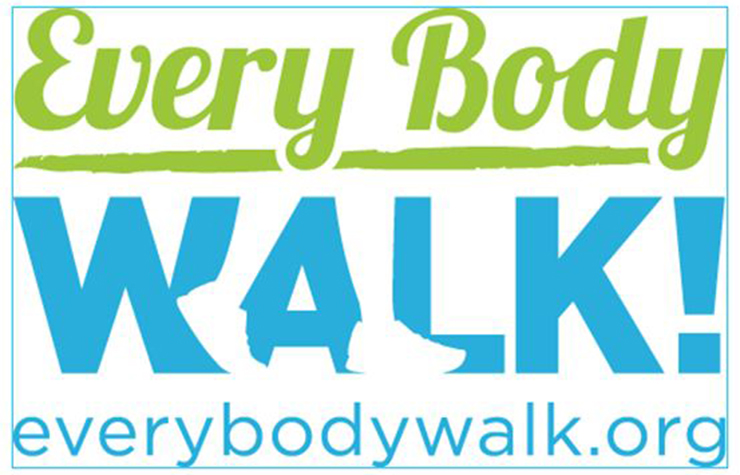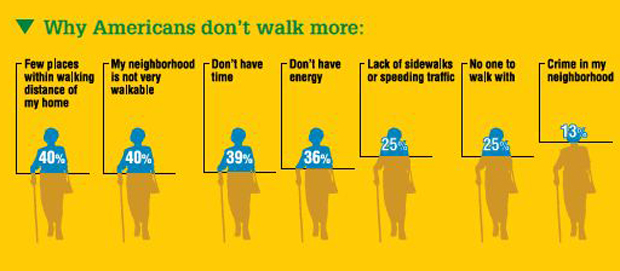AARP Hearing Center
A street that's made safer for an older adult to cross is also safer for a child walking to school, a parent pushing a stroller, a bicyclist, a jogger, a commuter, a shopper. In other words, a walkable community benefits everyone.


A Walking Plan
To step out in fun ways, EveryBodyWalk! recommends a themed approach to walking.
- January: Walk for your personal well-being
- February: Walk the "red carpet" (by showing off!)
- March: Take the stairs, not an elevator
- April: Walk at work
- May: Walk a dog (yours or a borrowed one)
- June: Walk with your family and friends
- July: Walk with people of different generations
- August: Walk on trails, in parks and other outdoor spots
- September: Walk to make a difference
- October: Walk to support a local business or downtown
- November: Take yourself for a walk
- December: Walk the mall while you shop
That's one reason AARP Livable Communities is working both nationally and locally to help towns, cities and neighborhoods become more livable and walkable for people of all ages. Among the other reasons?
- According to AARP research, nearly eight out of 10 people over the age 45 want to "age in place" by continuing to live in their own homes and a full 80 percent believe their current community is where they will always reside. However, with millions of boomers approaching their 70s and many not being able to drive or afford the costs of owning a car, communities need transportation alternatives for residents who don't or no longer drive.
- Walking for at least 30 minutes a day, five days a week can help adults improve their overall health and prevent disease. But obstacles and omissions — such as dangerous intersections, streets without sidewalks, poor maintenance of sidewalks, inadequate lighting — often discourage or prevent walking. (See the infographic below.)
- Walking is the second most popular means of travel among people age 65-plus, but according to the National Highway Transportation Administration, 19 percent of all pedestrian fatalities and 10 percent of all pedestrians injured were people 65 and older. The stats aren't much better for younger people: 5 percent all pedestrian fatalities and 15 percent of all pedestrians injured involved children 14 and younger.
To both encourage walking and pedestrian-friendly improvements to the built environment, AARP works with walk-minded organizations, among them:
- The Walkable and Livable Communities Institute, which provides tools and assessments for improving the safety and ease of walking in towns and cities nationwide.
- The National Complete Streets Coalition, which calls on elected officials and transportation planners to consider the needs of all roadway users — and not just vehicle drivers — when taking on new transportation projects or repairs.
- We also work with EveryBodyWalk!, a national collaborative and partner program of America Walks — a nonprofit with a mission to make America a great place to walk by promoting safe, convenient and accessible walking conditions and communities for all.
As part of the U.S. Surgeon General's "Call to Action" about walking, which was released in September 2015, EveryBodyWalk has been encouraging individuals to pledge to walk (see the box above) and then do so by, if needed for encouragement, walking in step with some monthly themes. (See box at right.)
Since July's theme — "intergenerational walking" — is apropos of what of AARP is working toward, we're providing a list of the pedestrian-promoting programs, resources and materials we've developed as part of our outreach to elected officials, government staffs, community leaders and citizen activists nationwide.
Fact Sheets and Tool Kits
How To's
- Guide to Evaluating Complete Streets Projects
- How to Get a Traffic Light Installed
- How to Host a Ciclovia or Open Streets Program
Interviews
- Anthony Foxx, Secretary, U.S. Department of Transportation
- Gil Penalosa, Founder 8 80 Cities, Open Streets Expert and Advocate
Slideshows
Articles and Reports
- Why Walking is Going Places
- Dangerous by Design Report 2014
- 13 Solutions for a More Walkable America
- AARP Livable Communities Walkability Archive
Featured Infographic


From "Walking as a Way of Life," a survey report for EveryBodyWalk! and Kaiser Permanente.
Melissa Stanton is the editor of AARP Livable Communities.
Page published September 2015



























































